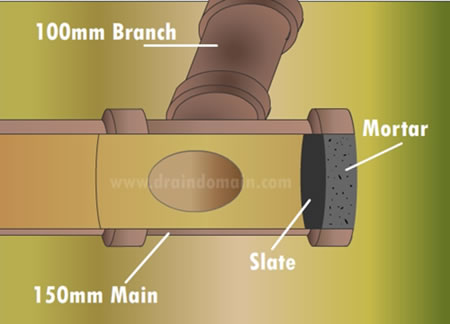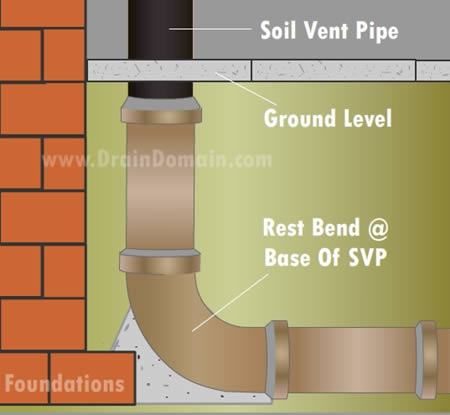
Most Visited
Rats In Your Home
Drain Flies
Why Drains Block
Internal Venting
Who`s Drain Is It ?
Drain Surveys
No-Dig Repairs
Drain Location
Drain Rods Stuck
Find A Contractor
Drain Pipe Work
Clay Drain Pipes
Plastic Pipe Work
Pitch Fibre Pipes
Cast Iron Pipes
Concrete Pipes
Drainage Parts
Drain Gullies
Dropshafts
Interceptor Traps
Soil Vent Pipes
Anti-Flood Valves
Manholes
Drain Repairs
Excavations
Drain Lining
Patch Lining
Pipe Bursting
Re-Rounding
Drainage
Investigations
Drain Surveys
Sonar Tracing
Last updated 7 January, 2014
draindmain.com > site map > drainage bends
Drainage BendsSimply enough these are the changes of direction on a drainage system which are usually available from 11 ¼ to 90 degree in most materials, long and short radius bends are available and they can be plain ended as shown below left (clay) or single or double socket (underground plastic).There are also adjustable bends available in plastic that allow you to achieve 0 to 30 degrees of turn. They are just as prone to defects such as root ingress or damage due to vehicular movement as any other part of a drainage system, they are however more prone to internal damage from over zealous rodding or jetting particularly the sharper bends are constructed from clay.
You tend to find that the older clay systems were made up of 30, 45 and 90 degree bends with anything less being accomplished by opening up the joints slightly on straight sections of pipe work, because the joints were sealed with sand and cement it was easy enough to slightly off set each pipe and still maintain a water tight joint. As a result when you excavate and remove an old clay system you can be left with a conundrum when trying to match up your angles, particularly in a small and confined dig. Another favourite trick used on the old clay systems would be to use a junction instead of a bend with the unused upstream collar being capped off with a piece of slate and a mortar plug as shown in the image above right, often used where a 100mm branch line meets a 150mm main line as it not only saved using a bend it also saved the additional cost of using a 100mm to 150mm adaptor pipe Drainage Building RegulationsModern building regulation require that the entire drainage system to be accessible for cleaning and maintenance and this often requires an access point at the point of a sharp change in direction, the preformed plastic manhole basis are available with 90 degree channel bends as well as 45, 30 and 15 degree channels. Rest BendsA rest bend is in affect a 90 (or 87.5) degree bend usually situated at the base of a soil vent pipe, a drop shaft or beneath a downstairs toilet, the main difference from a standard 90 degree or quarter bend as they are also known is that they are long radius and they have a foot or support fin on their base. This is to help absorb the force of the flushed water as it hits the base of the bend and they would usually be installed on a bed of haunched concrete. In reality most rest bends are just a plain 90 degree bend with no special attention given with regard to the impact of the flushed water or for the additional support required beneath the bend itself, occasionally we will find a concrete base or a couple of bricks offered as a token gesture. Rest Bend Problems
|
||||||||||||||||||
| related pages - | drain patch repairs |
| drainage junctions | |
| drainage gullies | |
| find a contractor | |




